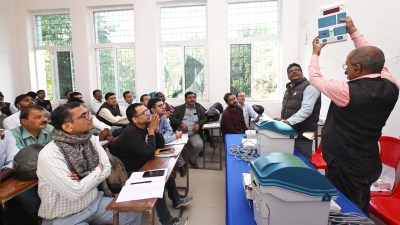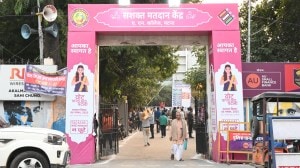China restaurant outbreak: Role of ventilation and ACs in spreading Covid-19
Researchers at the University of Minnesota have used advanced simulation methods to capture the complex flows that occur when the cold airflow from air-conditioners interacts with the hot plume from a dining table and the transport of virus-loading particles within such flows.
 Schematic of flow and particle transport, highlighting two transport pathways. (Source: Han Liu via American Institute of Physics)
Schematic of flow and particle transport, highlighting two transport pathways. (Source: Han Liu via American Institute of Physics)Last year, a restaurant outbreak in China was widely reported as strong evidence of airflow-induced transmission of Covid-19.
Why did some people get infected while others within the same area did not? What specific role did ventilation and air-conditioning play in transmission?
Researchers at the University of Minnesota have used advanced simulation methods to capture the complex flows that occur when the cold airflow from air-conditioners interacts with the hot plume from a dining table and the transport of virus-loading particles within such flows. The study has been published in the journal Physics of Fluids.
We are proud to announce that Jharkhand CM @HemantSorenJMM will be the Chief Guest of the discussion ‘Decoding India’s internal migration’ on February 12 at 2pm.
Register here to join: https://t.co/ngDRKfgS9T pic.twitter.com/7DLIk0HZju
“Our simulation captures various physical factors, including turbulent air flow, thermal effect, aerosol transport in turbulence, limited filtration efficiency of air conditioners, as well as the complex geometry of the space, all of which play a role in airborne transmission,” the American Institute of Physics, which publishes Physics of Fluids, quoted researcher Jiarong Hong as saying.
The study simulated the realistic case and linked it directly with the prediction of simulation. The results show a remarkable direct linkage between regions of high aerosol exposure index and the reported infection patterns within the restaurant. This provides strong support to airborne transmission in this widely reported outbreak, AIP said.
By using flow structure analysis and reverse-time tracing of aerosol trajectories, the researchers pinpointed two potential transmission pathways — the transmission caused by aerosols rising from beneath a table, and transmission due to re-entry aerosols (this was associated with limited filtration efficiency of air conditioners).
Source: American Institute of Physics



- 01
- 02
- 03
- 04
- 05



































